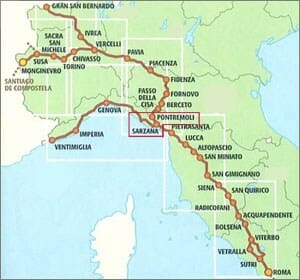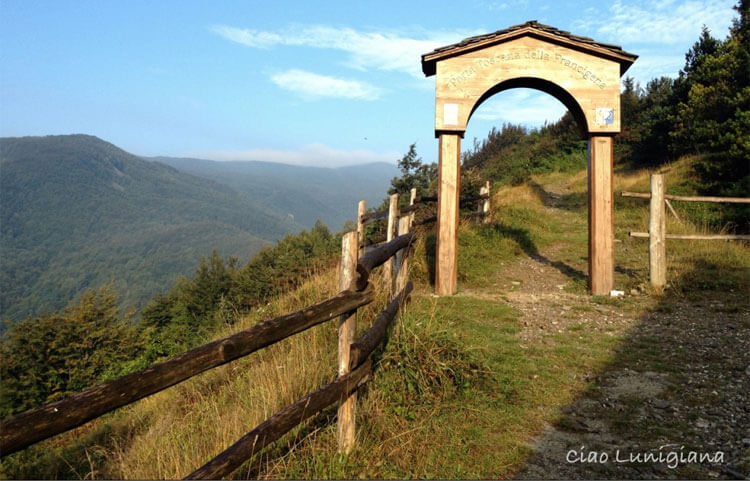The Via Francigena (or Romea Way) is the common name of an ancient road and pilgrim route  running from France to Rome, though it is usually considered to have its starting point much further away, in the English cathedral city of Canterbury. In mediaeval times it was the main route for those wishing to visit the Holy See and the tombs of the apostles Peter and Paul.
running from France to Rome, though it is usually considered to have its starting point much further away, in the English cathedral city of Canterbury. In mediaeval times it was the main route for those wishing to visit the Holy See and the tombs of the apostles Peter and Paul.
One of the historic French-bound routes runs along the entire length of Liguria, starting from Ventimiglia on the western tip; while the other ancient itineraries enter the region in Pontremoli. All pilgrims – whether departing from France or England – would eventually pass through Sarzana, the town where both paths met to proceed south towards Rome.
The traditional and most popular Francigena Way is the one that arrives from Canterbury. In eastern Liguria, it borders the Gulf of Poets by passing through the villages of Pontremoli, Aulla, Santo Stefano Magra, Fosdinovo (Sarzana), and Ortonovo (Luni). This territory, known as Lunigiana, is described by the Archbishop of Canterbury – Sigerico – who recorded his pilgrimage in his diary in 990.

Along the Francigena Way from Aulla to Sarzana (Lunigiana)
Attractions that can still be admired today along the Via Francigena in Lunigiana, include:
-
- Church of San Pietro: it is one of the most ancient religious buildings in Pontremoli and it was a reference point for pilgrims travelling along the Francigena Way. On its right-hand wall, you’ll find a sandstone plaque from the XII century, depicting a circular labyrinth surmounted by two characters with horses that most likely represent a traveler and the dangers awaiting him. Thought to represent the life of Christians, it was probably an allegory linked to pilgrimage.
- Filattiera: a Byzantine village featuring a 13th-century castle and the small Church of San Giorgio. This church preserves an epigraph of medieval Lunigiana: it recalls the deeds of Leodegar, who converted the inhabitants to Christianity, built churches, and gave bread to pilgrims along the Via Francigena.
- Villafranca: the town features the Lunigiana Ethnographic Museum, ruins of Malaspina castles and walled Byzantine villages; the Church of Santa Maria di Groppofosco and an abandoned farmhouse that provided for the pilgrims of the Via Francigena.
- Santo Stefano di Magra: Thanks to its strategic location and its hospice housing pilgrims and travelers, this was one of the most important stopping points not only of the Francigena Way, but also for people heading to Santiago de Compostela in Spain.
- Sarzana: Today’s Via Mazzini crosses the town lined with stores, cafés and restaurants. It is the original Via Aurelia, the much traveled pilgrim road leading to Rome. Do not miss the two ancient Romanesque churches of Sant’Andrea and Santa Maria (mini guide to Sarzana).
- Luni: all roads once passed through what today is the archaeological area of the ancient Roman city of Luni. Here you can still breathe the art and culture of a flourishing civilization where the history of Lunigiana started.
Whether you are a pilgrim, a believer or just a traveler, you will find the Francigena Way to be an inspiring and beautiful path through past and present, between medieval villages, Roman cobbled roads, greenery and modern buildings!
Discover more from Discover Portovenere Blog
Subscribe to get the latest posts sent to your email.